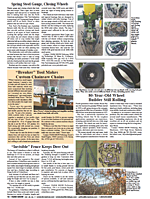2024 - Volume #48, Issue #5, Page #17
[ Sample Stories From This Issue | List of All Stories In This Issue | Print this story
| Read this issue]
Mesh Traps Catch Wild Pigs
 |
“It came about because necessity is the father of invention,” says Aaron Sumrall, Pig Brig’s Director of Research Education and Outreach. “Guam is a jungle environment, so it was impossible to bring in prefabricated panels, short of using a helicopter. Their traps also had to be attached to existing vegetation rather than using posts due to buried armaments left over from WWII.”
The resulting circular traps are 20 ft. in diameter and can be either attached to trees or used with 6 1/2-ft. T-posts driven into the ground. The netting hung on the inside of the posts or trees is heavy-duty and specially engineered with a drop strength of just under 8,000 lbs. to sustain the assault of even the largest pigs trying to escape.
A training period is usually required to introduce the pigs to the trap and make them feel comfortable. This is done by raising the bottom mesh skirt up and out of the way while placing bait like dry shell corn or peanut hay and castings around and underneath the trap for a few days.
“Pigs are smart animals, and if we try to force them to go somewhere they’re wary of going, we’ll actually push them away,” Sumrall says. “Once the entire sounder is comfortable and eating the bait, we just lower the skirt to the ground and let the pigs take care of the rest.”
He says that since they naturally love to root, they’ll make their way under the skirt to enter the trap. When they try to leave, they’re standing on the loose skirt, which reaches about 3 ft. inside, so their weight works against them.
“The trap is basically a rubber band,” Sumrall says. “Whenever a pig runs at one side trying to escape, the force isn’t hitting a single spot but is absorbed throughout the entire net as it flexes.”
He explains that the larger the number of caught pigs, the easier it is on the trap as they can’t generate enough speed due to other pigs blocking their way.
“It’s a completely quiet trap, too, so nothing lets them know they’ve made a mistake until it’s too late,” Sumrall says. “The most we’ve caught in a single event is 78 and 307 over 15 days in one location.”
The Pig Brig trap works year-round, but efficiencies decrease after spring green-up when more food sources become available.
“The best time to trap is once it gets colder and throughout the winter when there’s less natural feed,” he says. “We can push them away if we keep trapping after spring, so it’s a good time to maintain equipment for functionality and check the records for the optimal trapping locations.”
The U.S. Pig Brig traps are manufactured in Connecticut. An international manufacturer is used for their out-of-country markets due to high tariffs.
“We take a lot of pride that they’re built in the U.S.,” Sumrall says. “For our international market, we continue to have our thumb on quality control. We’ve only been in business for just over 40 months, and we already have traps in 34 countries.”
The Pig Brigs come in Regular and XT models with everything supplied except posts. The only difference is that the XT has a 2-ft. wide cap that can be clipped or sewn to the top to minimize the chances of a pig escaping.
Prices for the Regular and XT traps are $2,500 and $3,000, respectively. Costs include support, warranty, and customer service. The website features instructional videos.
Contact: FARM SHOW Followup, Pig Brig, 100 E. Pine St., Orlando, Fla. 32801 (ph 833-744-2744; info@pigbrig.com; www.pigbrig.com).

Click here to download page story appeared in.

Click here to read entire issue
To read the rest of this story, download this issue below or click here to register with your account number.




